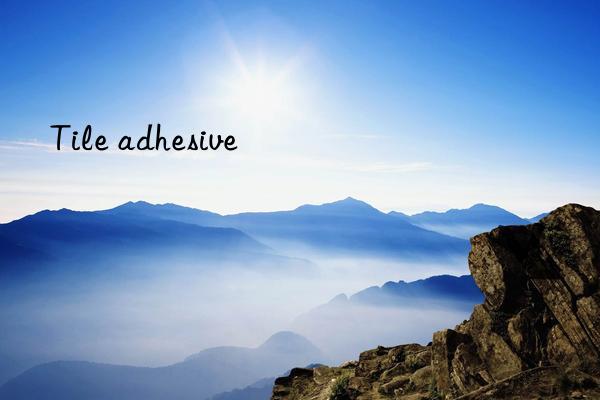
Ceramic tiles used inside and outside buildings are not a new invention. Egypt, India and China produced the first ceramic wall coverings in the form of murals and mosaics some 3,500 years ago. Ceramic tiles provide an aesthetically pleasing decorative surface as well as important functional advantages such as being waterproof, hard, long-lasting, hygienic and easy to clean. For these reasons, ceramic tiles are a very important floor and wall covering material in the construction industry. In 1999, the output was approximately (4.5×109m2) and it was used all over the world. The most important market is Asia (1.9×109m2), followed by Europe (109m2) and America (0.9×109m2). Ceramic tiles (non-frost-resistant porous tiles with a water absorption of approximately 25% according to EN 87) are mainly used indoors, while frost-resistant ceramic tiles (non-porous tiles with a water absorption of approximately 1%) are used indoors and outdoors. Various types of natural stone are used both indoors and outdoors. Today, fully vitrified ceramic tiles (ceramic tiles) as well as glass tiles with extra low water absorption (<0.1%) and good resistance to scratches, abrasions and weathering are increasingly used and are mainly used in outdoor applications and flooring . There is also an increasing use of large format ceramic tiles.
The bonding material for ceramic tiles and stone originally used thick-layer mortar mixed on site. This method is to mix sand and cement on site to make a simple cement mortar with a cement/sand ratio of about 1/4-1/5. This mortar is applied to the back of water (pre)soaked or pre-moistened tiles to a thickness of 15-30mm, and the mortar-coated tiles are pressed onto the pre-moistened surface. The tiles are then tapped to ensure a consistent flatness so that the final thickness of the mortar layer is 10-25mm. This process not only compacts the mortar, but also the fine cement particles into the porous back interior of the tile and into the porous substrate. With this method, the tiles embedded in the screed must be mechanically fixed or reinforced. And after the cement hardens, the mortar on the base also needs to be reinforced. Because this simple mortar is not slip-resistant, tiling must start from the bottom, and positioners must be used between tiles to achieve a neat joint.
However, this method is very time-consuming, uses a lot of materials and requires skilled workers. They must decide whether the substrate and tiles are suitable for this method. Depending on the porosity of the tiles, the tiles need to be soaked for a certain period of time. The mortar must be mixed in the correct proportions and consistency, and the back of the tiles must be coated before laying. Take the correct amount of mortar. More importantly, the modern construction industry has many restrictions on the use of this technology. For example, due to the mechanical reinforcement of the mortar required with this method, only porous and relatively small-sized ceramic tiles can be used on porous, solid and solid inorganic surfaces (foundations).
Therefore, today in most industrialized countries, thin-layer mortar technology has replaced the thick-layer mortar method. Polymer-modified prepackaged dry-mix mortar, mixed with water, can be applied with a serrated trowel to large areas of the surface to be tiled (troweling technique) to provide a mortar layer of uniform thickness. Since the thin-layer mortar has good water retention capabilities (the effect of cellulose ether), neither the tiles nor the base (foundation) need to be pre-soaked or pre-wetted. The tiles are then pressed into the screed with slight rotation. If the adhesive mortar uses enough additives and is mixed in the right proportions, the tiles that have just been applied to the newly prepared mortar layer will not slip.
This way, there is no need to insert positioners between the tiles, and tiling can be done from top to bottom. Depending on the size of the trowel teeth used (usually 6×6×6mm depending on the size of the tiles and the flatness of the base), the thickness of the adhesive mortar layer will be approximately 2-4mm. Therefore, thin-layer mortar technology is more cost-effective than thick-layer mortar technology. And it uses less materials, has a wider range of applications, and is simpler, faster and safer to operate. This is even more significant when the foundation is uneven and must be leveled first with leveling mortar.
This specially designed thin-layer technology of pre-packaged dry-mix bonding mortar is suitable for the modern construction industry on a variety of substrates and coating materials, and under various extreme climatic conditions. Today, there are a variety of adhesives for ceramic tiles available depending on the substrate to be laid and the tiles to be used: standard and flexible, normal and fast-setting, as well as special adhesives, such as white mortar for natural stone, waterproofing adhesive, for floor tiles Pouring mortars, gypsum-based adhesives and highly flexible mortars for new screeds, etc.
Dry-mix mortar for thin-layer tiling must meet various technical requirements, such as good workability, good water retention, long opening and adjustment times at high temperatures, and good slip resistance Mobility, etc. After hardening, cement-based adhesive mortars must be used on various covering materials (such as natural stone and various ceramic tiles) and various foundations (such as concrete surfaces, brick structures, lime-cement plasters and base coats, plaster, wood , old ceramic tile surfaces, gypsum wallboard, aerated lightweight concrete, particle board, etc.) provides high bonding strength even after exposure to frost, moisture and permanent immersion in water. In addition to providing good adhesion, thin layer adhesive mortarIt must also be flexible enough to absorb and reduce the tension between the foundation and the tiles caused by the different coefficients of thermal expansion of the covering material and the base and the potential for movement of the foundation. </p



 微信扫一扫打赏
微信扫一扫打赏
